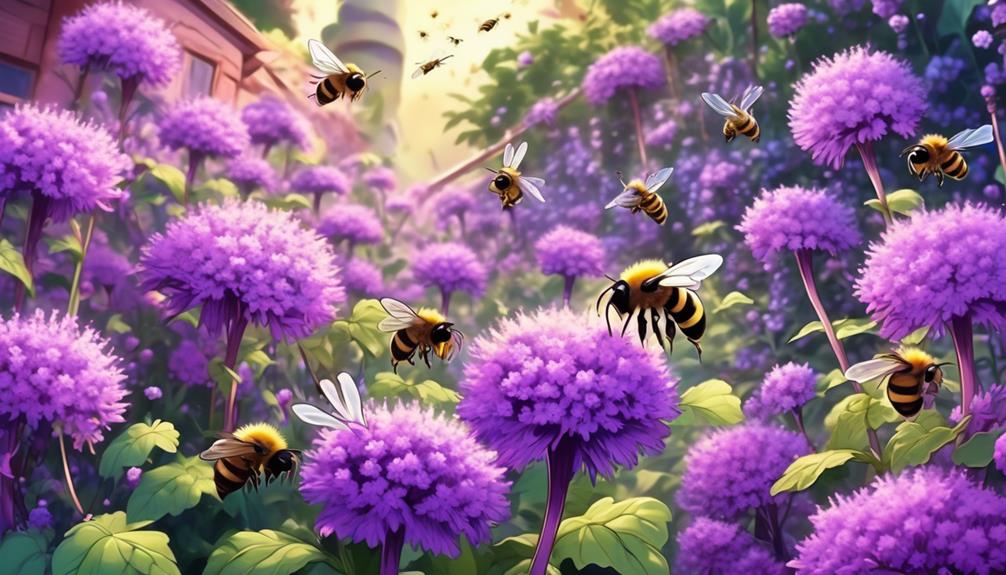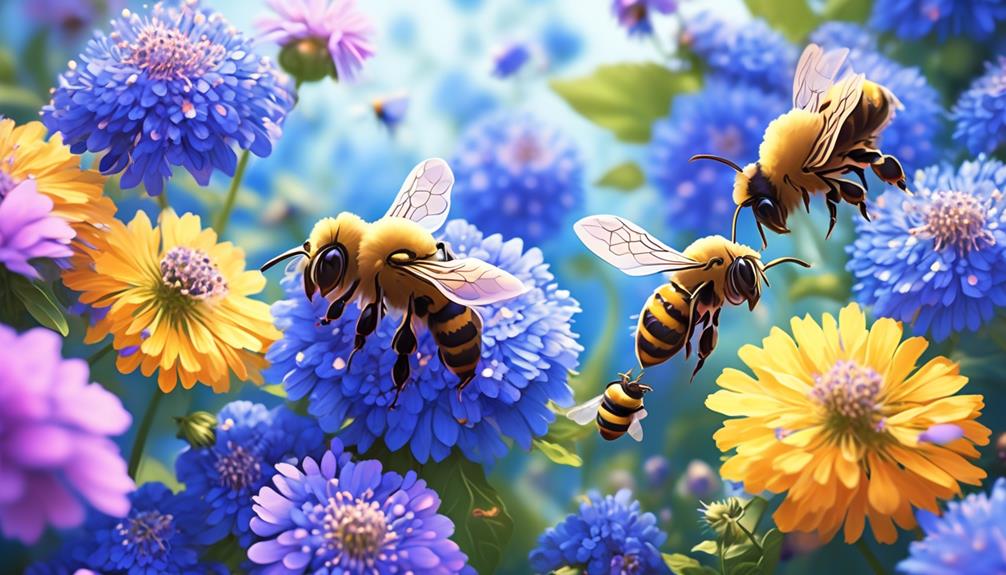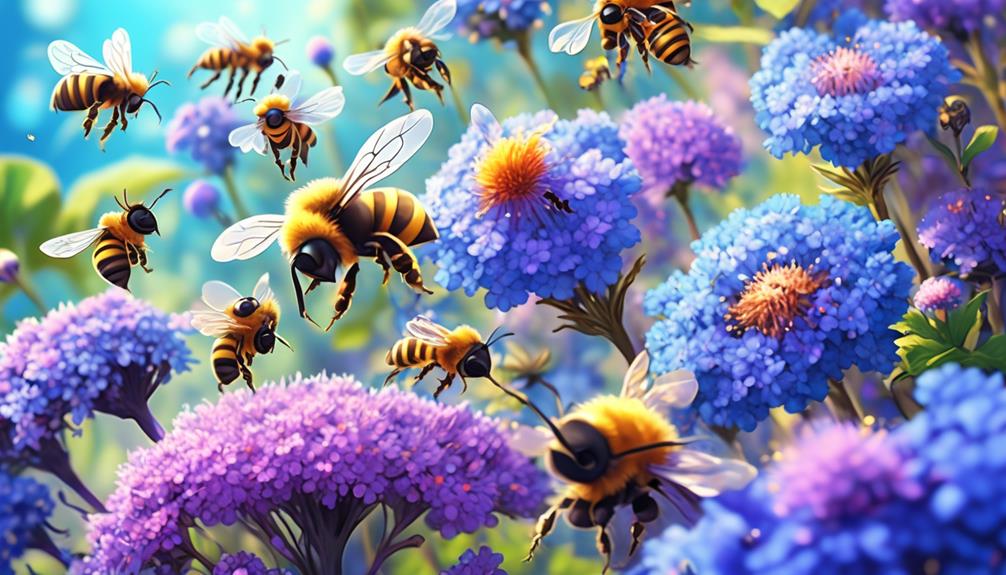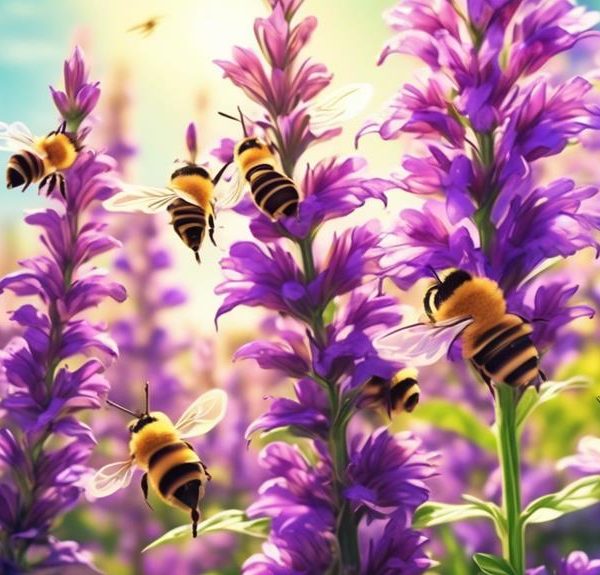A delve into the intriguing world of bees and their possible fascination with the charming blue ageratum blooms.

Do Bees Like Ageratum?
Peering into the world of bees and their flower preferences is like unraveling a ball of twine; it's complex, fascinating, and full of unexpected turns.
You may wonder, do bees take a liking to ageratum, those charming blue blooms that often grace our gardens? It's widely known that bees are drawn to certain flowers more than others, but where does ageratum fall on their list of nectar-rich favorites?
The relationship between bees and flowers is a delicate dance that shapes our environment, and understanding it could change the way you see your garden. But, before we get to the heart of the matter, let's first set the scene.
Key Takeaways
- Ageratum's vibrant blue flowers attract bees due to their visibility in the ultraviolet spectrum.
- Ageratum's nectar and pollen serve as important food sources for bees, providing them with energy, proteins, and nutrients.
- The unique flowering structure of Ageratum offers multiple feeding points for bees, maximizing their foraging efficiency.
- Including Ageratum and other bee-friendly plants in your garden helps support bee populations, enhance biodiversity, and contribute to a thriving ecosystem.
Understanding Ageratum and Its Appeal

Diving into the world of Ageratum, you'll quickly realize its unique appeal, not only for its vibrant blue flowers but also for the irresistible allure it holds for bees. A member of the Asteraceae family, Ageratum's botanical name, Ageratum houstonianum, pays tribute to William Houston, a Scottish surgeon and botanist. It's a popular choice among gardeners, thanks to its low maintenance needs and continuous blooming from spring to fall.
You'd be intrigued to know that Ageratum's attraction for bees isn't just cosmetic. The plant's nectar and pollen serve as vital food sources for these industrious insects. Ageratum's nectar, rich in sugars, provides bees with the energy they need to fly and carry out their daily activities. The pollen, on the other hand, contains proteins and other nutrients essential for bee growth and development.
Furthermore, Ageratum's unique flowering structure, an inflorescence composed of many small florets, gives bees multiple feeding points, increasing the efficiency of their foraging. So, when you're planting Ageratum, you're not only enhancing your garden's aesthetic but also contributing to the survival of these vital pollinators.
Bees' Role in Pollination

Let's explore the crucial role bees play in the pollination process, acting as nature's most efficient and industrious pollinators. Imagine a world without these tireless workers. It'd significantly impact the biodiversity of our ecosystem and our food supply.
Pollination, in essence, is the act of transferring pollen from the male anther of a flower to the female stigma. It's crucial for plant reproduction, allowing for the production of seeds. Bees are instrumental in this process. As they forage for nectar and pollen, they inadvertently carry pollen grains from the anther of one flower to the stigma of another, facilitating cross-pollination.
Bees' bodies are designed perfectly for pollination. Their fuzzy bodies trap pollen, and their specially adapted hind legs, known as pollen baskets, carry these grains back to the hive. It's estimated that a single bee can visit up to 5,000 flowers in a day. That's a lot of pollination!
Attraction Factors: Bees and Flowers

Building on the crucial role bees play in pollination, it's important to understand what precisely attracts these hardworking insects to certain flowers over others. Bees are primarily attracted by the color, scent, and nectar of flowers. Different species of bees may have preferences for certain colors and types of nectar.
Here's a simple table to illustrate these attraction factors:
Attraction Factor | Description | Example |
|---|---|---|
Color | Bees are particularly attracted to bright, warm colors like yellow and blue. | Sunflower, Ageratum |
Scent | Many flowers emit fragrant scents that allure bees. | Roses, Lilies |
Nectar | The sweet liquid produced by flowers serves as a major food source for bees. | Clover, Daisies |
It's also crucial to note that the shape and structure of the flower can affect its attractiveness to bees. For instance, tubular flowers like Ageratum provide a landing platform for bees, making it easier for them to access the nectar and pollen. The interplay of these factors determines whether a bee will visit a particular flower species, thus influencing the patterns of plant pollination in an ecosystem. Understanding this can help in the conservation of bees and in enhancing plant biodiversity.
Ageratum: A Bee Magnet?

In the realm of bee-friendly plants, Ageratum emerges as a particularly attractive option due to its unique combination of color, scent, and flower structure. The vibrant blues, purples, and whites of Ageratum flowers aren't merely aesthetically pleasing; they're also highly visible to bees. You see, bees perceive colors differently than humans. They're drawn to the ultraviolet spectrum, which Ageratum's bright hues effectively reflect.
Moreover, Ageratum's sweet scent also serves as a potent lure. While it's pleasant to our noses, for bees, it's a signal of nectar-rich flowers, a crucial food source. The plant's scent compounds, known as volatile organic compounds or VOCs, are easily detected by a bee's sophisticated olfactory receptors, leading them directly to the nectar source.
Lastly, the flower structure of Ageratum is ideal for bees. The composite flower heads are dense clusters of tiny flowers, each offering nectar and pollen. This maximizes the bees' foraging efficiency, as they can gather more food with less flying around.
Enhancing Your Garden for Bees

To enhance your garden and make it a haven for bees, consider incorporating a variety of bee-friendly plants like Ageratum, which offer a rich source of nectar and pollen, essential for their survival. Bees are not only attracted to Ageratum's bluish-purple flowers, but also their distinct scent, contributing to the biodiversity of your garden.
To help you plan your bee-friendly garden, here's a concise table representing other plants you might want to include.
Plant | Color | Bloom Time |
|---|---|---|
Lavender | Purple | Summer |
Sunflowers | Yellow-Gold | Summer-Autumn |
Sage | Purple | Spring-Fall |
Coneflower | Pink-Red | Summer-Autumn |
Mint | White | Summer-Fall |
These plants not only provide nectar and pollen, but also create a vibrant and colorful landscape. Remember, a healthy bee population is vital for pollination, contributing to a thriving ecosystem. By diversifying your plant selections, you're not only enhancing the aesthetic appeal of your garden but also supporting the local bee community. You're literally making your garden buzz with life!
Frequently Asked Questions
What Other Insects Are Attracted to Ageratum Besides Bees?
Apart from bees, various other insects are drawn to ageratum. You'll often find butterflies fluttering around these plants, attracted by their vibrant blooms.
Additionally, they're a big hit with hoverflies, which are beneficial for pest control. However, be cautious, as ageratum also attracts less welcome guests like aphids and whiteflies.
It's a balancing act to encourage the beneficial insects while managing the harmful ones.
How Do Bees Contribute to the Growth and Propagation of Ageratum?
You're probably aware that bees play a key role in the growth and propagation of many plants, including ageratum. They do this through pollination.
When bees collect nectar, they unintentionally pick up pollen on their bodies. As they move to the next flower, some of this pollen gets transferred, facilitating fertilization.
This leads to the production of seeds, which ensures the continuation of the plant species. Thus, bees are critical for ageratum propagation.
Are There Any Negative Effects of Bees Pollinating Ageratum?
There aren't any known negative effects of bees pollinating ageratum. In fact, it's quite the opposite. When bees pollinate ageratum, they help the plants reproduce and spread. This action benefits both the bees, who get nectar from the flowers, and the ageratum, which thrives as a result of the pollination.
It's a symbiotic relationship. So, you see, bees pollinating ageratum isn't only harmless but also essential for the survival of these plants.
Can Ageratum Survive Without Bee Pollination?
Yes, you'll find that ageratum can survive without bee pollination. They're self-fertile plants, meaning they don't need bees to reproduce. The pollen from the stamen of the flower can fertilize its own ovule.
However, bees do enhance the process and increase the plant's genetic diversity by cross-pollinating between different ageratum plants. So, while bees aren't necessary for their survival, they do contribute to their health and diversity.
What Types of Bees Are Most Attracted to Ageratum?
You're asking what types of bees are most attracted to Ageratum.
Well, Ageratum, with its bright colors and sweet nectar, is especially enticing to honeybees and bumblebees. These bees are attracted to the plant's blue flowers, which they can see very well. Additionally, the plant's shape makes it easy for these bees to access its nectar and pollen.
Conclusion
So, do bees like ageratum? You bet they do! This vibrant flower isn't just a visual treat, it's a veritable bee magnet.
Its nectar-rich blooms and inviting fragrance make it a top choice for these tiny pollinators. By adding ageratum to your garden, you're not just enhancing its beauty, you're also supporting the crucial role bees play in pollination.
Now, isn't that a win-win situation for both your garden and the buzzing bees?


